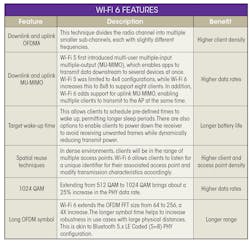Connecting the Future: Three Wireless Trends on the 2020 Horizon
Home and work life, commerce, industry, and transportation are all about connectivity these days. The Internet of Things (IoT) has impacted our lives and transformed industries over the past decade, and we expect even more wireless innovations to make their presence felt in 2020 and beyond.
I’m excited about three wireless technologies that are poised to enhance how we find and track things; share and stream data in our homes, offices and public spaces; and enable long-range connectivity for smart cities, factories, and agriculture. Let’s take a closer look at wireless indoor tracking technologies, the next-generation Wi-Fi 6 standard, and LPWAN protocols reaching the mainstream this year.
Location, Location, Location
Tech companies have been trying to solve the problem of “where is my stuff” for a long time, well before the rise of the IoT. While global-positioning-system (GPS) technology can be used to locate and track some devices such as smartphones, GPS is typically expensive and power-hungry, and it must be used outdoors to receive satellite signals. Indoor location tracking isn’t a practical option with GPS. Until recently, device makers have been solving the problem of indoor location services with a mix of technologies such as RFID and Bluetooth beacons, enabling precision location services.
We’ve seen two significant innovations in indoor tracking and location services gain traction this year: angle-of-arrival (AoA) and angle-of-departure (AoD) direction finding introduced in the Bluetooth 5.1 specification and ultra-wideband (UWB) radio technology. Both wireless technologies are being integrated into smartphones. Mobile phones have included Bluetooth LE radios as a standard feature since the early 2010s, and leading smartphone manufacturers are adding UWB radios to their latest models, such as Apple’s inclusion of UWB in the iPhone 11 and 11 Pro.
Historically, two trends occur when a new technology enters the smartphone ecosystem: cost and power consumption plummet. We will see this happen with the integration of both AoX and UWB technologies in the latest smartphones. Consumers will be able to use their smartphones to locate things with precision in a way they haven’t before. For example, users can pinpoint the exact location of their phones, key fobs, and tracking tags.
- In parallel, equivalent tracking technologies can be embedded in infrastructure itself. For example, AoX and UWB can be used to create asset management and tracking systems for locating packages in warehouses. It’s time to bring GPS-like tracking capabilities to indoors applications. As Bluetooth AoX and UWB tracking technologies become ubiquitous this year, you won’t have to wonder where your stuff is much longer.
Wi-Fi 6: The Next-Gen Wireless Standard
Wi-Fi 6, also known as IEEE 802.11ax, is a major milestone in the Wi-Fi standard’s 20-year journey of continuous innovation. The standard builds on the strengths of 802.11ac while adding greater efficiency, flexibility, and scalability that gives new and existing networks increased speed and capacity for next-generation applications.
The IEEE proposed the Wi-Fi 6 standard to deliver the performance and versatility of high-speed Gigabit Ethernet wireless combined with the reliability and predictability of a licensed radio. For reference, the Wi-Fi Alliance has rebranded the wireless standard. In the past, Wi-Fi versions were branded according to the IEEE standard nomenclature, but this approach was confusing to consumers. Going forward, here’s the Wi-Fi “decoder ring”:
- Wi-Fi 4 = IEEE 802.11n
- Wi-Fi 5 = IEEE 802.11ac
- Wi-Fi 6 = IEEE 802.11ax
Wi-Fi 6 is the first short-range wireless standard developed to enable a high density of devices embedded into the specification. Previous Wi-Fi versions focused on speed and performance first and foremost. Think of Wi-Fi 5 (802.11ax) like a bullet train. Data can move around quickly, but there won’t be many high-speed trains on the track at the same time.
Wi-Fi 6 was built from the ground up with device density in mind. The standard supports a host of new features addressing density, battery life, and wireless range, in addition to other features designed to increase raw data throughput capabilities, as shown in the table.
With the arrival of Wi-Fi 6, we will see an increase in the number of devices able to connect to a Wi-Fi network, along with reduced latency, longer battery life, and an enhanced overall user experience. Wi-Fi 6 chips are already hitting the market, and several access-point manufacturers are releasing products compliant to the specification. Smartphone manufacturers are expected to add Wi-Fi 6 to next-generation handsets, while connected-device manufacturers will include the new wireless technology in a range of IoT products this year.
LPWAN for the Long Haul
Cellular technology is starting to migrate from smartphones and into the IoT as a viable option for low-power wide-area-network (LPWAN) connectivity. Several semiconductor suppliers including Nordic Semiconductor, Qualcomm, Sequans Communications, and Sony (Altair) are releasing chipset products supporting the NB-IoT and LTE-M (also known as CAT-M1) cellular standards, and interesting startups like Riot Micro also are entering the cellular IoT market.
LTE-M is a good option for LPWAN applications requiring a combination of long battery life, LTE reliability and low latency. LTE-M is also compatible with existing LTE networks and in the future will coexist with 5G technologies.
Equivalent non-cellular LPWAN technologies operating in the sub-GHz band, such as LoRaWAN (a protocol managed by the LoRa Alliance running on Semtech’s LoRa RF platform), are beginning to go mainstream. A recently unveiled LPWAN option to watch closely this year is Amazon’s 900-MHz Sidewalk protocol, designed to connect sensors, lightbulbs, trackers (for things and pets), and other long-range IoT devices.
IoT device manufacturers now have many options for deploying LPWAN connectivity at lower costs, enabling a rapidly improving developer experience for long-range, low-data-rate, low-power applications. By operating in the sub-GHz band or a licensed cellular spectrum and keeping the data bandwidth relatively low (tens of bits per message), LPWANs can achieve a range measured in the tens of kilometers. This wider coverage range has broad implications in leveraging the IoT and machine-to-machine (M2M) communications for smart cities, building and home automation, and industrial IoT.
According to ON World, LPWAN services are expected to reach $75 billion USD by 2025, serving more than 30 different applications in a broad range of market segments globally. LPWAN technology is now finding its way into transportation, from long-haul trucking to electric dockless scooters; urban infrastructure such as parking meters and gas and water meters; and smart farming applications, including precision agriculture and livestock monitoring.
With so many new and emerging wireless technology options coming onto the market this year, connected device makers will continue to drive innovation in the IoT, and end users everywhere will be the ultimate beneficiaries.
Daniel Cooley is Senior Vice President and Chief Strategy Officer at Silicon Labs.
